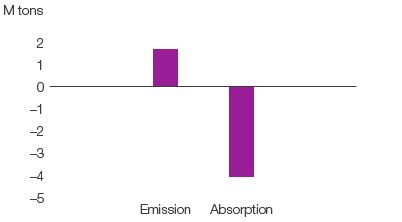Forest management
As Europe’s largest private forest owner, SCA takes a long-term approach to its responsible forest management.
Biodiversity
Around 2 million of SCA’s 2.6 million hectares of forest land are managed for timber production. The remaining 600,000 hectares of less productive forest, such as bogs, are still valuable as a living environment for flora and fauna.
Areas that provide vital habitats for sensitive fauna and flora are exempted from forest management or are managed with the aim of enhancing the existing environmental values and biodiversity. Approximately 200 species in SCA’s forests – over 100 species of insects, nearly 50 types of fungi and about 50 different kinds of mosses and lichens – are disadvantaged by forest management and require special consideration.
SCA has set aside nearly 7% of its managed forests to benefit biodiversity in its ecological landscape plans. SCA also takes extensive conservation measures in managing forest areas that do not contain any particular conservation value. During felling operations, individual trees, groups of trees and buffer zones are set aside to ensure that the conservation values inherent in older forests are preserved and become an integrated part of the new growing forest. In 2016, 13% of the 19,000 hectares planned for harvesting were preserved for nature consideration.
Seedlings
In 2016, SCA’s forest-tree nursery delivered 77 million seedlings, of which 48% were planted in SCA’s own forest land. The remainder of the seedlings was sold to other forest owners.
Conservation parks
Biodiversity is a key environmental consideration for SCA’s forest operations. SCA has established a total of five conservation parks, comprising a total of more than 10,000 hectares of forest land. At least half of the forest land must be earmarked for or managed in a manner that promotes biodiversity and cultural heritage. The parks are often located near other nature reserves in order to create large areas of protected forest. SCA uses the knowledge it gains in these parks in its other forest operations.
Forest management and certifications
The management of SCA’s forest land is certified in accordance with FSC’s and PEFC’s forest management standards and ISO 14001.
The 2016 FSC audit showed one minor deviation and three observations and the PEFC audit showed two minor deviations and two observations.
The minor deviation from the FSC standard was for the control of natural regeneration of lodgepole pine, which had previously been conducted in conjunction with surveying for thinning. As thinning of lodgepole pine has become less extensive, the control of natural regeneration has also decreased and must be replaced with another control method.
The auditors received one complaint ahead of the audit. A private individual had questioned whether SCA’s use of the Canadian tree species lodgepole pine complies with FSC standards. The audit firm has concluded that SCA complies with the requirements imposed by the FSC standard on the use of foreign tree species.
In summary, the audit firm concluded that all business operations at SCA Skog comply to a great extent with the requirements of ISO 14001 for the environmental management system and working methods, as well as the FSC’s and PEFC’s standards for responsible and sustainable forest management.
Forest as carbon sinks
SCA’s carbon dioxide emissions from own production and absorption in SCA’s forests

The 2016 net uptake of carbon dioxide in SCA’s forests was about 4.1 million tons, exceeding the carbon dioxide emissions from fossil fuel of 1.7 million tons generated by all of the Group’s production.
SCA’s 2.6 million hectares of actively and responsibly managed forests provide an impressive carbon sink. Young, growing trees need 1.375 tons of carbon dioxide to produce each cubic meter of wood, making them one of the most effective means to reduce carbon dioxide levels in the atmosphere. SCA forests have a net growth of 1.4%, resulting in a net carbon sequestration of SCA’s forests equivalent to 4.1 million tons in 2016. If half of the world’s forests were managed like SCA’s and deforestation was stopped, much of the climate change problem would be solved.
